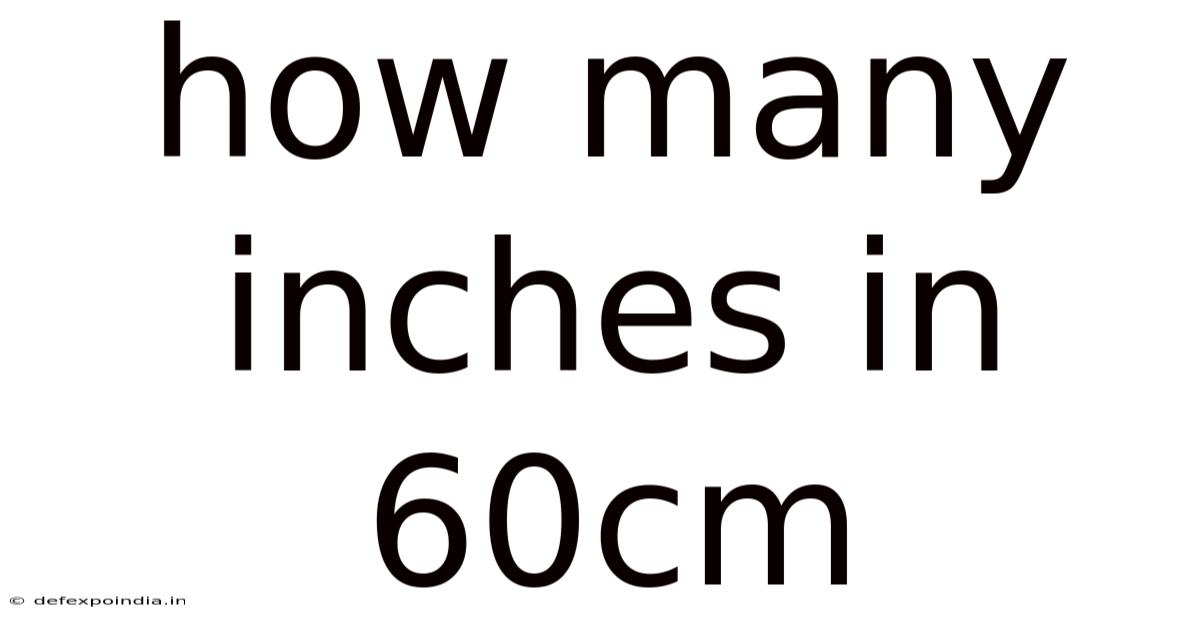How Many Inches In 60cm
defexpoindia
Sep 21, 2025 · 4 min read

Table of Contents
How Many Inches Are in 60cm? A Comprehensive Guide to Metric-Imperial Conversions
Knowing how to convert between metric and imperial units is a crucial skill, whether you're working on a DIY project, following a recipe, or simply understanding global measurements. This comprehensive guide will delve into the conversion of 60 centimeters (cm) to inches (in), exploring the process, the underlying principles, and providing you with a deeper understanding of unit conversion in general. This will be more than just a simple answer; we'll explore the history, applications, and even some potential pitfalls to avoid.
Understanding the Metric and Imperial Systems
Before jumping into the conversion of 60cm to inches, let's briefly review the two systems involved.
-
Metric System (International System of Units or SI): This system, based on powers of 10, is used globally and is characterized by its simplicity and ease of conversion. The base unit of length is the meter (m), with prefixes like kilo (1000), centi (1/100), and milli (1/1000) used to denote multiples and fractions of the meter.
-
Imperial System (or US Customary Units): Primarily used in the United States, this system employs units like inches, feet, yards, and miles. The relationships between these units are less intuitive than in the metric system, making conversions slightly more complex.
Calculating 60cm to Inches: The Direct Approach
The most straightforward method for converting 60cm to inches is using the conversion factor: 1 inch is approximately equal to 2.54 centimeters.
Therefore, to find the number of inches in 60cm, we perform the following calculation:
60 cm * (1 in / 2.54 cm) ≈ 23.62 in
This calculation shows that 60 centimeters is approximately equal to 23.62 inches. It's important to note the use of "approximately equal to" (≈) because the conversion factor is a rounded value. The precise conversion factor is 1 in = 2.54 cm, defined by international agreement.
Beyond the Simple Calculation: A Deeper Dive into Conversion Factors
The conversion factor (1 in / 2.54 cm) is the key to understanding this conversion. It represents the ratio between the two units. By multiplying the length in centimeters by this ratio, we effectively cancel out the "cm" units, leaving us with the equivalent length in inches. This principle applies to any unit conversion. The key is to find the correct conversion factor.
Practical Applications: Where This Conversion Matters
The ability to convert between centimeters and inches is incredibly practical in many situations:
-
DIY and Home Improvement: Many building materials and plans are presented in either metric or imperial units. The ability to convert between them ensures accurate measurements. Imagine building a shelf; using incorrect measurements could result in a poorly fitting or even unusable shelf.
-
Sewing and Tailoring: Patterns may be presented in inches, while fabric may be sold in centimeters. Converting between the units ensures accurate garment construction.
-
Cooking and Baking: Recipes may use either metric or imperial units for ingredient quantities. Accurate conversion is crucial for achieving the intended result.
-
International Trade and Shipping: Products are shipped and traded globally, requiring consistent and accurate unit conversions to ensure proper dimensions and quantities are understood.
-
Engineering and Design: In engineering and design, precision is paramount. The ability to seamlessly switch between the two systems is essential to avoid costly errors.
Potential Pitfalls and Precision
While the calculation is straightforward, several factors can influence the accuracy:
-
Rounding: The conversion factor (2.54) is often rounded. Using a more precise value (e.g., 2.540000) can increase the accuracy of the conversion, especially for precise measurements.
-
Significant Figures: In scientific and engineering contexts, the number of significant figures used in the calculation is crucial for maintaining the precision of the result.
Frequently Asked Questions (FAQ)
-
Q: Is the conversion factor 2.54 exactly correct? A: The conversion factor 1 inch = 2.54 centimeters is defined as an exact conversion. However, in practical applications, rounding might occur leading to slight variations.
-
Q: How can I convert inches to centimeters? A: To convert inches to centimeters, simply use the inverse of the conversion factor: Multiply the length in inches by 2.54 cm/in.
-
Q: Are there online converters available? A: Yes, numerous online converters provide instant conversions between various units, including centimeters and inches. These tools can be very convenient, but understanding the underlying principles remains important.
-
Q: What about other units of length? A: The principles of conversion extend to other units of length within both the metric and imperial systems. You can use similar methods and conversion factors to translate between feet, yards, meters, kilometers, and so on.
Conclusion: Mastering Unit Conversions for a Connected World
Understanding how to convert 60 centimeters to inches – and more broadly, mastering the art of unit conversion – is an essential skill in our increasingly interconnected world. This ability transcends simple arithmetic; it empowers you to navigate various contexts, from DIY projects to international collaborations. By grasping the principles behind the conversion factors and understanding the potential for minor inaccuracies due to rounding, you gain confidence in handling measurements regardless of the system being used. Remember, the key is to not just memorize the answer but understand the underlying process, enabling you to tackle any unit conversion challenge with ease and accuracy.
Latest Posts
Latest Posts
-
7 1 2 As A Decimal
Sep 21, 2025
-
7 Degree Fahrenheit To Celsius
Sep 21, 2025
-
How Much Is 70 Meters
Sep 21, 2025
-
20 Uncji Ile To Gram
Sep 21, 2025
-
How Long Is 12 Inches
Sep 21, 2025
Related Post
Thank you for visiting our website which covers about How Many Inches In 60cm . We hope the information provided has been useful to you. Feel free to contact us if you have any questions or need further assistance. See you next time and don't miss to bookmark.